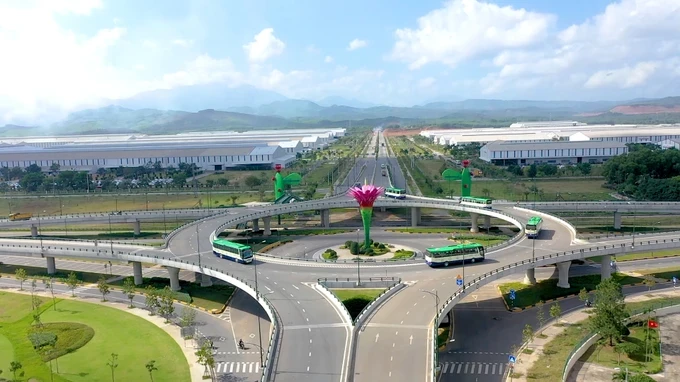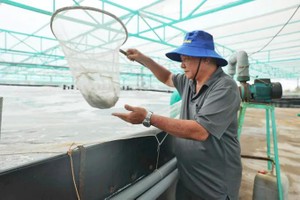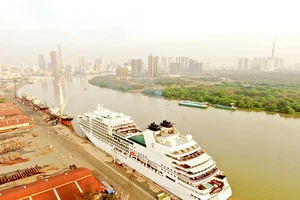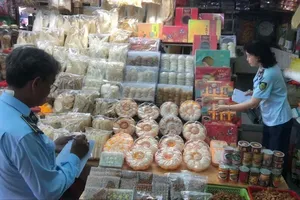
For many generations, people living in the downstream of Lam River in Nghi Xuan District of Ha Tinh Province and those in Cua Lo Town of Nghe An Province were separated by the large and dangerous river. Thanks to the introduction of the 5.2-kilometer long Cua Lo Bridge in 2019 with an investment of VND950 billion (US$37.3 million), they can now foster mutual development in economy, culture, and entertainment.
Enjoying the peaceful atmosphere of Nam O fishing village (Lien Chieu District of Da Nang City), which is classified as intangible cultural heritage, 74-year-old Tran Ngoc Vinh shared that formerly, residents of this village nearly live remotely from other neighborhoods. Due to the opening of the first ‘5-star’ coastal road of Nguyen Tat Thanh, which is 10km long, his village and others like Xuan Ha and Thanh Binh have become more vibrant.
Opposite this road is the coastal route of Vo Nguyen Giap – Truong Sa – Hoang Sa, which runs along internationally beautiful beaches in Vietnam, turning the used-to-be poor area into a bustling place with series of resorts and high-class hotels. The route has successfully exploited the land resource advantage to facilitate the growth of tourism, services, logistics for marine economy in various localities in the Central region.
Chairman Tran Dinh Truc of the People’s Committee of Cat Tien Town (Phu Cat District of Binh Dinh Province) stated that his town has transformed into such a lively urban area for tourism and renewable energy production like now all thanks to the newly constructed coastal route. At the moment, more tourism projects worth thousands of billions of VND are being started to exploit the De Gi Sea.
Similarly, Vo Chi Cong Road has allowed better access to the 20,000-hectare land resource along the sea of Quang Nam Province, attracting a large number of investors. Many high-class resorts are being built, some of which are worth billions of dollars like the one in the two districts of Duy Xuyen and Thang Binh, invested by Nam Hoi An Development Co. Ltd.
President/CEO Steve Wolstenholme of Hoiana Resort & Golf commented that the coastal road linking Da Nang City to Chu Lai Airport in Quang Nam Province is a key traffic infrastructure to be the foundation for a strong growth of tourism in the area. It allows more development eastwards to accommodate luxurious resorts for long trips as well as high-quality golf courses.
Nghi Yen Commune in Nghi Loc District of Nghe An Province is welcoming a large Thai corporation coming to investigate conditions for a new resort construction project. Another interesting place for tourism is in Cua Lo Town, whose connection to the hometowns of Uncle Ho (Nam Dan District) and celebrated poet Nguyen Du (Nghi Xuan District) are near enough to form a historical tour.
The industry sector of the Central region also benefits from the coastal routes as a series of large-scale FDI projects have been activated in Tam Hiep Port Logistics Industrial Park, offering jobs for the local.
In the end of 2023, Da Nang City started a VND800-billion project to expand National Highway No.14B to six lanes in order to connect Tien Sa Sea Port in Lien Chieu District of Da Nang City to Chan May Port in Thua Thien-Hue Province and to Ky Ha – Chu Lai Port in Quang Nam Province. The route can also run to the Central Highlands then to Cambodia and Laos, forming another East-West economic corridor (EWEC) in parallel with the current one for further economic development in the Central region.
Besides, Da Nang City is concentrating money on its international tourism port of Tien Sa, sited near major historical heritages of Vietnam like the former capital of Vietnam – Hue, Hoi An ancient town, My Son international cultural heritage. This will serve global tourists from other countries like the UK, the US, Germany, and China.
At the summit for EWEC links of five localities in the three nations of Vietnam – Laos – Thailand, Chairman Le Trung Chinh of the People’s Committee of Da Nang City proposed that each nation should try to complete its own road traffic infrastructure upgrades, plus the introduction of a consistent policy for procedures and fees to pass national borders so that the competitiveness for commodities transportation on EWEC can be increased.
Da Nang City itself is going to consider developing an electronic database system to offer logistics services to business members of the EWEC ecosystem for ease of carrying out import-export tax procedures. More connections on the EWEC should be made to facilitate the growth of tourism and culture along this route.
In a recent working session with the central delegation, Binh Dinh Province has asked for a budget to build the Quy Nhon – Pleiku Expressway with a length of 143km and a capital need of VND37.6 trillion ($1.48 billion). Binh Dinh Province highly appreciates the cooperation on EWEC of the three countries of Vietnam – Laos – Cambodia
The central delegate agreed with the strategic importance of the Quy Nhon – Pleiku Expressway as to economy, livelihood, and national defense. This route can better exploit the potential of the economic triangle of Vietnam – Laos – Cambodia.
In addition, the Prime Minister has already approved the project for a cluster of four Inland Container Depot (ICD), namely South Pleiku, Le Thanh, Thi Nai, and Quy Nhon for economic transport of containers.
Particularly, Quy Nhon Sea Port is EWEC’s nearest gate to the East Sea, meaning Binh Dinh is playing a critical role in the northern part of the South Economic Corridor (SEC) in the Mekong sub-regions (including the provinces of the three countries: Bangkok - Siem Reap - Stung Treng - Ratanakiri - Pleiku - Quy Nhon). Binh Dinh is trying its best to foster the growth of this East-West corridor for a stronger inter-regional bond among the three countries.
The coastal area of Nghi Loc District and Cua Lo Town in Nghe An Province is accommodating bloodline routes to the two important sea ports of Cua Lo and Nghi Thiet. Nghe An Province is pouring money to turn the route into a logistics center for the whole North Central region to serve various marine economic zones from Thanh Hoa Province to Thua Thien-Hue Province.
























